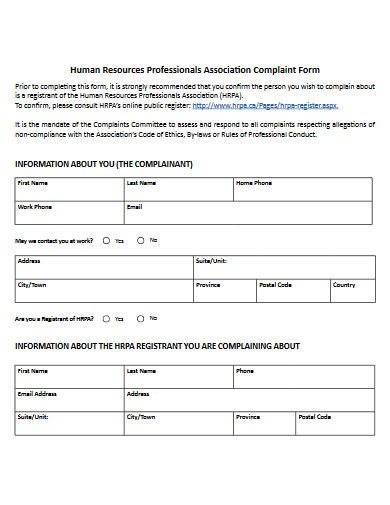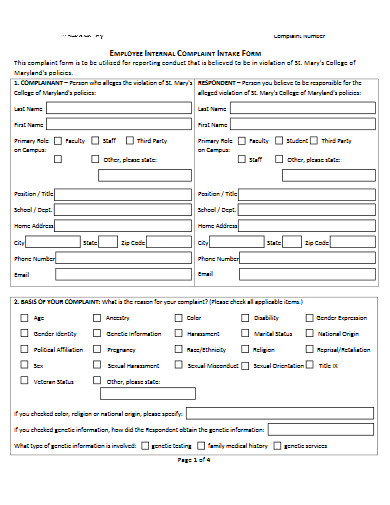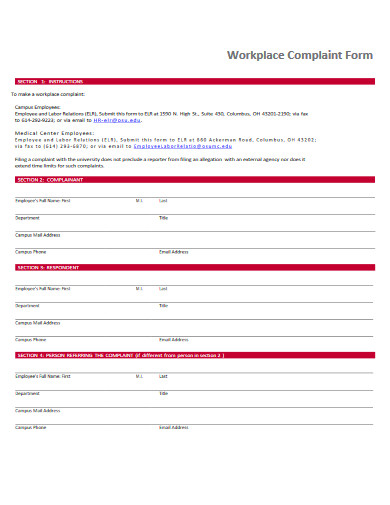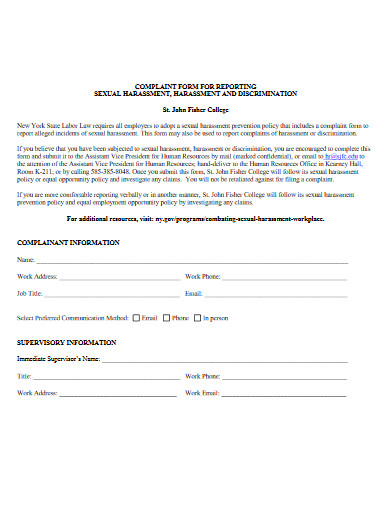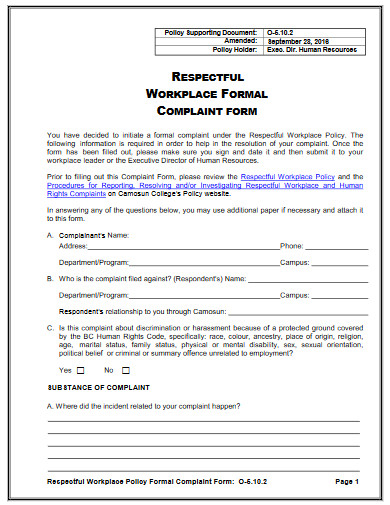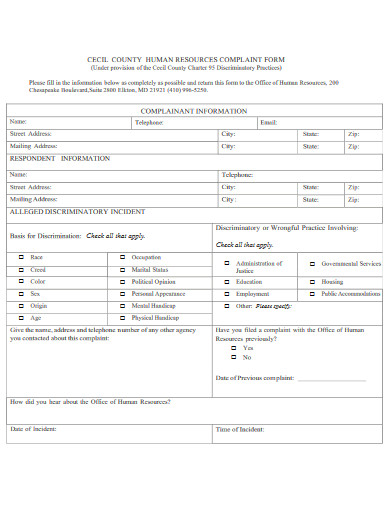10+ HR Complaint Form Examples to Download
One of Harvard Business Review’s (HBR) articles affirmed that more or less 98% of the organizations in the United States have a sexual harassment policy. The latter type of harassment is just one of the many grievances that employees raise to their respective human resource departments. Once harassment of any form occurs, the harassed employee has to file a formal document that details his or her concern on his or her experienced unfair treatment or unwanted incident. The victim’s company has to proceed with its complaint resolution process by planning and then implementing its investigation procedures and disciplinary actions. In case you’re wondering what these documents look like, you better check out our various examples below.
10+ HR Complaint Form Examples
1. Free HR Complaint Form Template
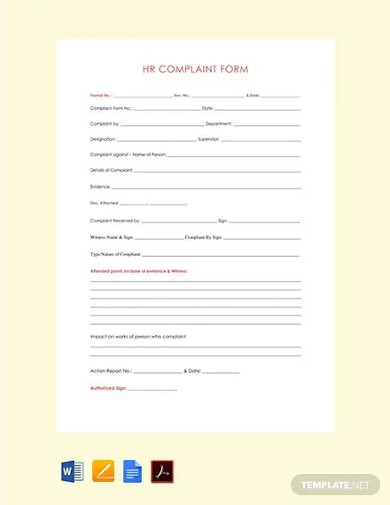
2. Free HR Employee Complaint Form
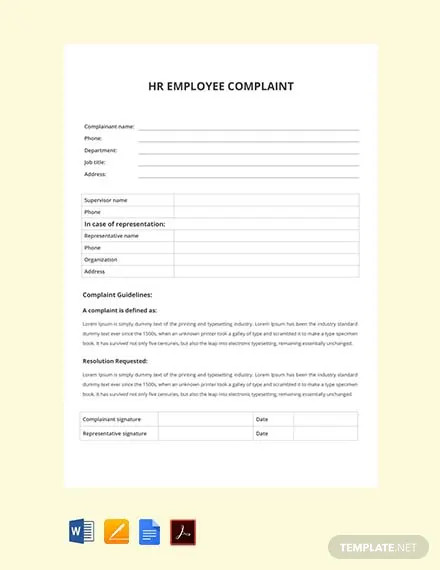
3. Free HR Professionals Association Complaint Form
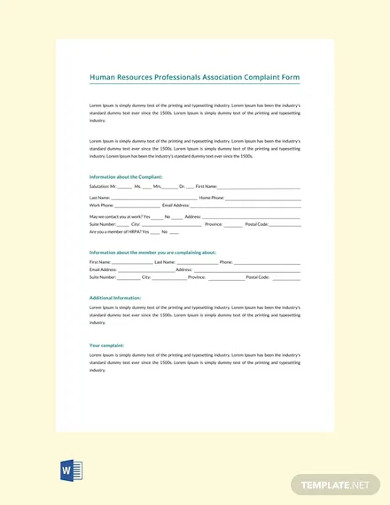
4. Free HR Employee Complaint/Concern Form Template

5. Free Individual Employee HR Complainant Form
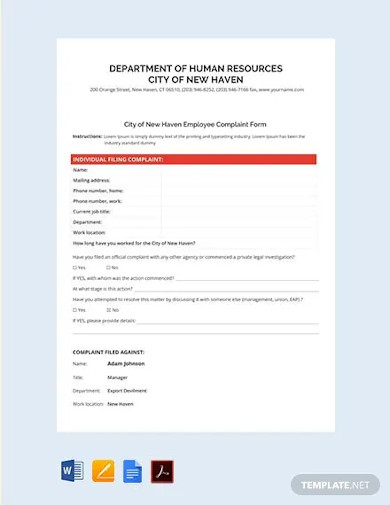
6. Human Resources Association Complaint Form
7. Employee Internal Complaint Intake Form
8. HR Workplace Complaint Form
9. Sexual Harassment HR Complaint Form
10. HR Workplace Formal Complaint Form
11. Human Resources Complaint Form
What Is an HR Complaint Form?
An HR complaint form is a fillable business-type document that helps gather pieces of information about company complaints. Aside from workplace harassment, this form also considers disputes on the compensation plan, commission plan, payment plan, and other employee-employer related issues. The document guides complainants of what information to include while maintaining uniformity in gathering data in all types of complaints. It also helps the human resource staff in executing the documentation policy and documentation procedure with the utmost convenience. Because of these facts, such a document is, without a doubt, an important part of the HR’s list of tools.
Types of Workplace Harassment
Employees need to understand what’s considered harassment and what’s not. This is so you’ll know when to speak up about an ordeal that affects your physical and mental state in the workplace. Here are the different types of workplace harassment:
1. Discriminatory (victims are persecuted because of their race, gender, religion, disability, sexual orientation, and age)
2. Personal (unseemly comments, jokes, remarks on the victim, as well as humiliating, casting off, and intimidating them)
3. Physical (threatening to harm or physically attack another employee, and destruction of property for intimidation)
4. Power (harasser bullies his or her subordinates using his or her organizational power)
5. Psychological (denial of the victim’s presence, belittling the victim’s opinions, spreading false information about the victim, and opposing everything that the victim says)
6. Online (sharing humiliating information, spreading lies, and sending inappropriate messages to the victim through online platforms)
7. Retaliation (employee harass the other employee as a revenge to past conflict)
8. Sexual (sharing pornographic materials, making sexual comments, jokes, and questions, sexual touching and gestures, invasion of personal space in a sexual manner)
9. Quid Pro Quo (offering something in exchange for a sexual favor)
10. Third-Party (harassment made by individuals outside the organization)
11. Verbal (threatening, yelling, insulting, or cursing at the victim publicly or privately)
How To Create an HR Complaint Form
It is the HR’s top priority to keep all the professional relationships inside the organization intact. In view of that fact, the said department has to take complaints with a high level of seriousness. So, in gathering the necessary data for the complaints’ workplace investigation report, you have to ask the right questions in your HR complaint form. To guide you in doing that, follow the following steps:
1. Ask for the Basic Information of the Complainant
First things first, ask for the complainant’s basic information. You have to know his or her name, the department he or she’s in, email address, and phone number. This is one important step in the documentation procedure to learn one of the involved parties.
2. Request for the Basic Information of the Accused
Aside from the complainant, you also have to learn about the basic information of the accused. Since the complainant will be filling out this form, expect that you won’t be getting the exact or complete details of the one he or she is complaining about. As much as possible, try to get the name and double-check it in your company’s data inventory or database.
3. Ask the 5 Ws
In an investigation report, it is important to know what the issue is, who caused it, who’s the victim, when and where the incidents happened, and why he or she thinks it happened. The function of this form is to get these details ahead.
4. Let the Complainant Elaborate the Incident
Once you have those questions asked, let the complainant elaborate on how the incidents happened. Also, ask how often the issue happened and how the complainant reacted to it. Some complainants have already prepared a complaint letter. If given such a situation, you can let the complainant attach the letter instead.
5. Know If There Are Witnesses
The thing you have to know is if there are witnesses to the complainant’s incidents. If so, collect the witnesses’ basic information as well.
6. Ask for Pieces of Evidence
Apart from the witnesses, you should also ask for pieces of evidence. These things can help lessen the time of the investigation. Videos, as, and pictures are good examples.
7. Learn the Complainant’s Desired Outcome
There are many ways to punish the accused. In your form, let the complainant express what he or she wants to be done.
FAQs:
What are some examples of discriminatory harassment?
Good examples of discriminatory harassment are racial harassment, gender harassment, religious harassment, disability-based harassment, sexual orientation-based harassment, and age-based harassment.
What should a harassment policy include?
A harassment policy should include the definition of harassment, statement of prohibition, complaint procedure statement, disciplinary measures, protection against retaliation.
What are the punishments for harassments in the workplace?
If the accused is found guilty of harassment, he or she may face probation, termination, compensation, or jail time.
The human resource department of a certain company is bombarded with many duties and responsibilities. Even though some staffs are experts in handling a lot of them, there will come a time that they will reach their limit and will look for someone or something to help them with. For this very reason, we can conclude that an HR complaint form is a great tool that helps minimize their workload in cases of complaints. Not to mention, it helps a lot in the investigation process of such circumstances.



